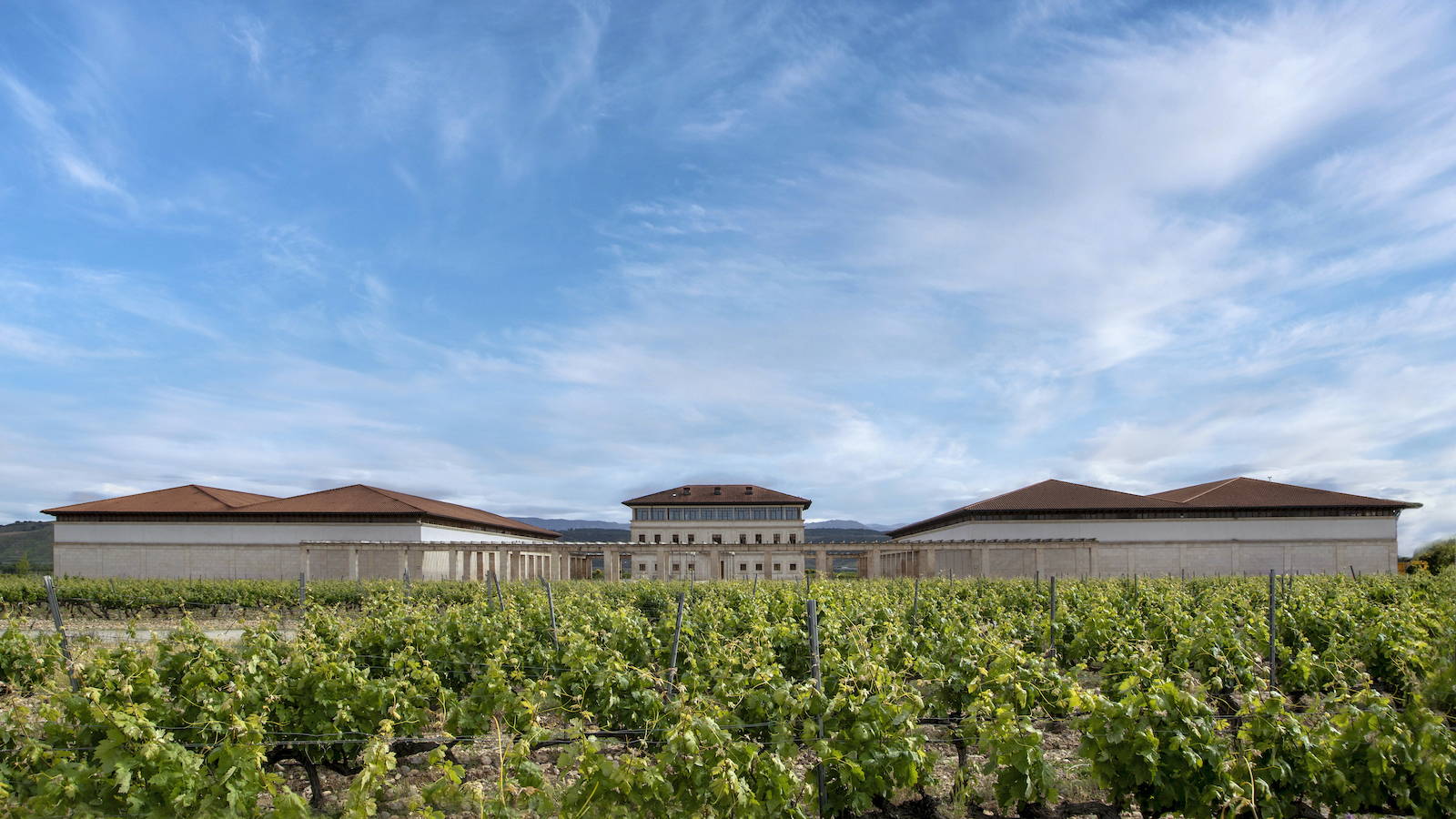From the south of Álava, through the north of La Rioja, and reaching the southwest of Navarra, the Sonsierra region covers a vast territory where the Cantabria and Codés mountain ranges converge, sheltering dozens of municipalities that today are linked to the Rioja Alavesa region. However, the Sonsierra extends beyond this, as the former Kingdom of Navarra attested, spanning from the town of San Vicente to Viana. It is here, in this municipality of the Sonsierra Navarra, that the winemaking tradition endures thanks to wineries like Rioja Vega.
Today, this area serves as a passage for pilgrims following the Camino de Santiago, but in the past, it was shepherds with their livestock who traveled along a royal cattle track from Mendavia to Oyón, which now crosses this winery. Known in those times as “Venta Jalón,” this location became home to Rioja Vega’s facilities 23 years ago, utilizing the 70 hectares of pre-existing vineyards to establish a winery in the purest ‘château’ style. This winery, part of the Príncipe de Viana Group, traces its origins back to 1882 when Felipe Ugalde founded the original estate in the heart of Haro. The building still bears the coat of arms that now graces the labels of bottles exported to nearly 50 countries worldwide.
While the history of Rioja Vega is one to be savored slowly, the harvest has already begun, returning the winery to the hustle and bustle of the season. Activity has intensified in recent days, with just a week since the first grapes arrived before fermentation began. All the white varieties—led by Tempranillo Blanco, along with Viura, Garnacha Blanca, and Verdejo—have already been harvested, shifting the focus to the red grape intake, particularly Garnacha and the Graciano estate, as the last clusters of Tempranillo await harvesting.
Esperanza Elías, the winery’s chief winemaker, references historical harvest dates from the past 15–16 years. “Look, we’ve almost returned to the dates of 12 years ago. This year was already slightly delayed from the start, during flowering, but September’s rains have pushed things back further. While there were occasional years like 2016 or 2018 when the harvest started later than usual, the overall trend has been an earlier campaign,” she explains.
A week ago, tractors hauling trailers were a rare sight on the roads, but now the harvest is in full swing. Initially, conditions pointed to an ideal harvest, but unexpected rainfall and a lack of wind led to delays. However, recent cooler temperatures have accelerated maturation and improved acidity. “We anticipated a staggered harvest, but now everything is happening at once. Normally, there’s a 15-day gap between white and red grape harvesting, but this year, we started picking Tempranillo Blanco and Tempranillo Tinto the very next day,” Elías notes. The Graciano variety has been particularly affected by erratic weather, which slowed its phenolic ripening.
In 2014, Rioja Vega made a bold move by launching one of the first barrel-fermented Tempranillo Blancos on the market. “We’ve always believed in its aging potential. That’s why we also produced a Reserva Blanco at a time when few wines of this style were available,” Elías recalls. The winery has also innovated with Graciano, producing a single-varietal version alongside its traditional blend with Tempranillo. Today, Rioja Vega offers 15 different labels.
The steady stream of grape-laden trailers blends with vineyard sampling, spanning elevations from 450 to nearly 700 meters, and cellar rackings. “Harvest is a nonstop effort,” Elías laughs. In the fermentation hall, she fills a glass straight from the tank—pure Tempranillo Blanco juice, soon to enter barrels for fermentation. Rioja Vega expects to harvest around one million kilos of grapes, with only 10% collected so far. The winery’s efficiency benefits from its 70 hectares of estate vineyards, primarily Tempranillo Tinto, Garnacha, and Graciano, surrounding the facility. The remaining grapes come from 15 growers in Viana, Mendavia, and Bargota. Despite this advantage, Elías anticipates a “delicate” harvest requiring close vineyard monitoring.
Key factors include vineyard location, altitude, rainfall, and soil type. To optimize conditions, Rioja Vega employs four meteorological stations monitoring vine, soil, and overall vineyard health, along with irrigation sensors to deliver precise water amounts. While irrigation hasn’t been necessary this year, the system ensures balance in poor soils that might otherwise struggle with maturation. “From the start, we’ve committed to technological advancements in both the winery and the field. This data benefits us and allows us to guide our growers toward better practices, ultimately improving profitability through quality-focused incentives,” Elías emphasizes.
As part of its ongoing innovation, Rioja Vega has promoted eco-friendly solutions like pheromone-based pest control to reduce chemical treatments and encouraged growers to graft vines with white or minority varieties aligning with market trends. “We see our growers as a pillar—not just for the winery but for the surrounding communities. Many of our relationships span years, bringing stability to everyone involved,” she adds.
Given the current surplus crisis facing the Rioja denomination, Rioja Vega has proactively limited red grape yields from all its suppliers to 5,000 kilos per hectare. “The situation is challenging, but we’re committed to maintaining our network of growers,” Elías concludes.
Source: nuevecuatrouno.com




